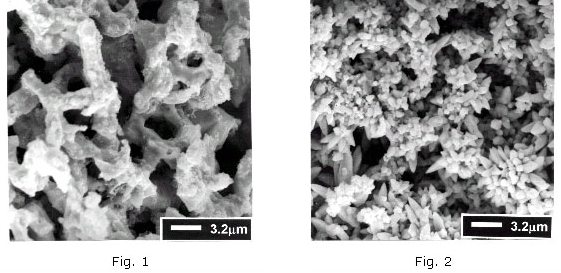Structure of NAM. NAM structure consists of lead crystals interconnected in a skeleton network [Fig.1] and secondary structure of separate lead crystals deposited on the lead skeleton surface [Fig.2].

The skeleton structure is formed during the first stage of formation when PbO and basic lead sulfates are partially reduced to lead, and partially react with H2SO4 to give PbSO4. These processes proceed at neutral pH of the solution in the pores of cured plates. The secondary structure is formed during the second stage of formation when PbSO4 crystals are reduced to lead crystals under acidic conditions. On battery discharge, current is generated mainly at the expense of oxidation of the secondary lead structure (energetic structure). The primary (skeleton) structure serves both as a current collector and as a mechanical support for the energetic structure. It is mostly the energetic structure that participates in the charge-discharge processes at the negative plates.
Influence of expander on the structure of negative plates. In the absence of expander, negative active mass with dendritic secondary structure is formed, which yields a relatively low surface area and capacity of the plates. Expanders enhance the formation of a secondary structure containing separate small lead crystals deposited on the surface of the skeleton. The morphology and size of these crystals depend on the nature of the expander used. Plates containing expander have higher capacity and longer cycle life. The effect of expander on the primary NAM structure is clearly revealed during the service life of the battery under deep charge-discharge cycling conditions. When the negative plates contain no expander, the NAM skeleton shrinks and the active mass becomes more compact as the individual Pb crystals are transformed into large skeleton branches. A reverse effect is observed in the presence of a highly efficient expander. The skeleton structure is loose and the plates grow in thickness. This is an evidence that the skeleton is partially involved in the cycling processes forming energetic structure. This transformation of the structure reduces the density of the negative active mass.
References
- D. Pavlov, V. Iliev, Structure of the active mass of the negative plate of lead-acid batteries, J. Power Sources, 7 (1981) 153
- V. Iliev, D. Pavlov, The effect of the expander upon the two types of negative active mass structure in lead-acid batteries, J. Appl. Electrochem., 15 (1985) 39
- D. Pavlov, E. Bashtavelova, V. Iliev, Structure of the lead-acid battery active masses, Advances in Lead-Acid Batteries, Proceedings of the International Symposium, Vol.84-14, p. 16, Electrochem. Soc. Inc., Pennington, USA, 1984
Theses
V. Iliev, PhD: Structure of the active mass of the negative lead-acid plates and its functions
Keywords: structure of NAM, primary NAM structure, skeleton NAM network, secondary NAM structure, energetic structure, morphology of lead crystals, expander influence on NAM |
